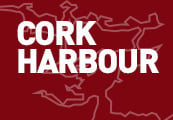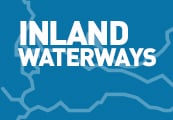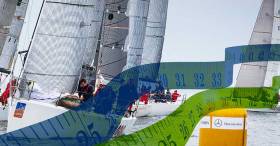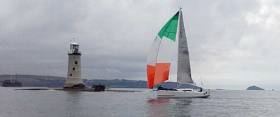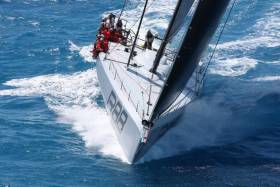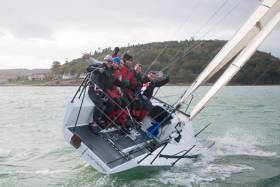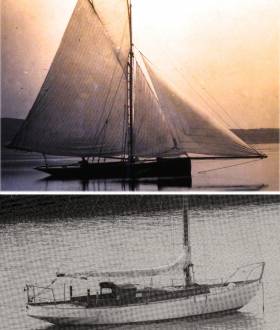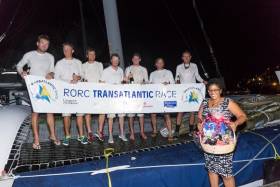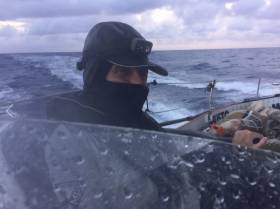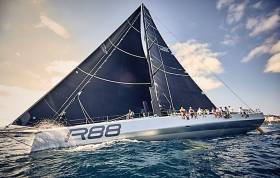Displaying items by tag: RORC
ICRA To Run IRC Measurer’s Course At Royal Cork Yacht Club
Royal Cork Yacht Club in conjunction with ICRA and RORC will be running an IRC Measurement weekend on the 5th, 6th and 7th of May.
The aim of this weekend is two fold:
IRC Measurers:
• To train up new people on the south-coast to be qualified to measure boats. This will be done over the one evening and two day course, the cost of this will be €50 per person and will include lunch during the course.
Boat Measuring:
• While the course is on, RORC will be offering to measure boats at a substantial discount to normal cost, so if you are interested in getting your boat weighed and measured it will be done here in Crosshaven for a cost of €200 per boat. Spaces will be limited for this offer so it will be on a first come first served basis.
If you are interested in either of the two option planned for this weekend as places will be limited, so book early to ensure you get in. Further details here.
Howth Yacht Club's Conor Fogerty Prepares For Ostar Race 2017
This month sees Conor Fogerty of Howth Yacht Club, preparing for one of the most prestigious and demanding solo ocean races in the international yachting calendar.
The latest instalment of the OSTAR (Original Solo Transatlantic Race), commences on 29th May 2017.
This will see Fogerty, bring his much loved and widely campaigned Sunfast 3600 'Bam', to the start line off Plymouth Sound in the English Channel. This gruelling race which is taxing on both body and mind, heads across the North Atlantic Ocean, to Newport Rhode Island, over 3,000 miles of Ocean.
Although the race name OSTAR may trip easily off the tongue, this generally upwind race, is not for the faint hearted or indeed occasional offshore adventurer.
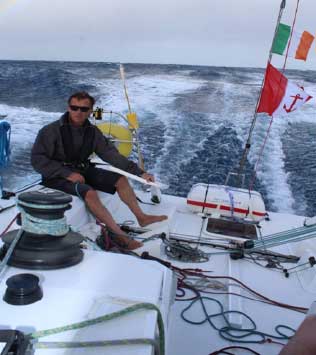 Fogerty and Bam surfing at 20–knots during a 2016 transatlantic crossing
Fogerty and Bam surfing at 20–knots during a 2016 transatlantic crossing
The event sees the solo skippers pit themselves against strong gales and big seas as a matter of course, not to mention, ice, fog, shipping and the occasional whale attack is not unknown.
He will follow in the footsteps of a veritable who’s who of sailing greats and pioneers of ocean racing. The names of Chichester, Knox Johnson, Blyth, Tabarly, Peyron, not forgetting Ellen McArthur are some of those who have sailed this great race before him.
In an Irish context, solo sailor Barry Hurley of the Royal Irish Yacht Club took a class win in the 2009 Ostar after a 21–day match race with an Italian competitor.
OSTAR history can be traced to an English war veteran Blondie Hassler who set about organising the race in 1956 and saw it first run in 1960 under the guidance of The Royal Western Yacht Club. From those early days of sextants and hand bearing compasses, the race has witnessed the trialling of most major innovations in boat design and on board equipment common in modern day sailing. This includes the advent of multi hulls, autopilots, water ballast, GPS, and weather routing. Whilst all of the above have certainly revolutionised sailing for the modern day solo adventurer, they do little to diminish the stark reality of dealing with the conditions, the low pressure systems of the North Atlantic create.
 After 21 days at sea Barry Hurley makes a dawn finish and a class win in the 2009 Ostar
After 21 days at sea Barry Hurley makes a dawn finish and a class win in the 2009 Ostar
Conor is a seasoned campaigner. Last year alone saw his 11–metre Bam start the year with a win in the RORC Caribbean 600. From there a 16–day solo trip to the Azores and then after some much needed R &R in Horta, back to Ireland.
Next up were the ISORA races across the Irish Sea and forays to the South Coast of England and North of France competing in RORC races. Not forgetting a 3rd place finish in the Round Ireland and a Solo Fastnet (SORC) challenge, which but for a fickle wind at the end line, would have seen him claim the top of the podium. The season came down with the Middle Sea Race off Malta which saw Fogerty and Bam claim the 3rd overall in class for the RORC 2016 season.
This was a fitting reward for skipper and crew for the thousands of hard miles campaigning in 2016, without the big budgets of some competitors or indeed sponsorship.
It has been said that the major achievement racing the OSTAR is to get the boat to the start line.
These campaigns do not come easily or cheaply to the racing privateer. The aim now is to get as many sponsors as possible on board, to back this commendable Corinthian challenge.
Conor is in discussions with potential sponsors at the moment, but he also provides a grass route sponsorship option for an individual to have their name displayed on the hull to show support, and to give his attempt every chance of success, and to fly the Irish flag with distinction. If you are interested in providing support, please contact [email protected]
Round Ireland Record Holders To Set The Pace In The Caribbean
Next month, more than 70 yachts are expected to take part in the RORC Caribbean 600, the Royal Ocean Racing Club's stunning race around 11 Caribbean islands. American yachts have had a winning streak in this classic offshore race, winning five out of eight editions of the 600-miler, starting and finishing in Antigua.
With 16 entries, the largest number of American boats ever seen on the race course will include several serious race teams with a chance of winning the overall trophy. Past winners from the U.S. on the start line on Monday 20th February will include the current holder of the RORC Caribbean 600 Trophy from 2016, George Sakellaris, Proteus, Maxi 72 (USA) as well as some of the other American overall winners: 2015: Hap Fauth, Bella Mente, JV72 (USA); 2014: George Sakellaris, RP72, Shockwave (USA); 2013: Ron O'Hanley, Privateer, Cookson 50 (USA) and 2011: George David, Rambler 100, JK 100 (USA).
Favourites, for both line honours and the overall win are likely to come from the USA, even though British contenders lead the impressive list of entries in terms of number of boats from around the globe.
The fastest boat in the race is the American trimaran, the MOD70, Phaedo³ owned and skippered by Lloyd Thornburg who grew up in Santa Fe, New Mexico. Phaedo³ set the multihull record last year, hurtling around the course at speeds in excess of 30 knots and topping out nearer 40, crossing the finish line in an elapsed time of 31 hours, 59 minutes, 04 seconds and breaking their previous race record. Team Phaedo is back to defend their title and will be taking a tilt at their own record once again.
15 Maxi yachts have already entered the RORC Caribbean 600, including American Maxi, Rambler 88 skippered by George David from New York. In 2011, George David's Rambler 100 scorched round the track in a time of 40 hours 20 minutes 02 seconds setting the monohull race record and winning the race overall. This year, George David's Rambler 88, although smaller than his previous Rambler 100, will be hoping for the right conditions to better the race record.
Two American owned boats, that on recent results must be regarded as joint favourites, are the highly tuned and professionally sailed Maxi 72's, Proteus and Bella Mente. George Sakellaris from Massachusetts, USA has won the race twice before and will hope to be the first team to retain the RORC Caribbean 600 Trophy and win the race for a third time. He will however have to beat the highly competitive world-class team on Bella Mente, skippered by Hap Fauth from Long Island, New York. Bella Mente won the race overall in 2015, however, last year the Maxi72 had to retire after suffering a major failure to her keel.
Two-time Olympian and multiple World Champion, Mark Mendleblatt from Florida, USA has won the race as part of George Sakellaris' afterguard and will be racing on Proteus this year:
"I don't know why more American boats do not participate," commented Mark Mendleblatt. "From Florida you can easily deliver the boat there on its bottom. Logistically, the race starts and finishes in Antigua and the marina, facilities and accommodation are excellent and less expensive than back home. The RORC Caribbean 600 is a fantastic race with great breeze, a lot of tactical calls, manoeuvres and sail changes. The start line is something really special; racing past a dramatic coastline, with superyachts, schooners and top ocean racers. During the race there is no respite and we are sure to have a great battle with Bella Mente. Whoever pushes the hardest will probably win. I am happy to take any role on board, but when you are at the helm with world class trimmers and crew calling the breeze in fast reaching conditions, it is the kind of racing that we all dream about."
Over 900 sailors from 24 different countries are anticipated to take part in the 2017 RORC Caribbean 600.
RORC CARIBBEAN 600 TROPHY - IRC OVERALL WINNERS
2016 - George Sakellaris, Proteus Maxi 72 (USA)
2015 - Hap Fauth, Bella Mente, JV72 (USA)
2014 - George Sakellaris, RP72, Shockwave (USA)
2013 - Ron O'Hanley, Privateer, Cookson 50 (USA)
2012 - Niklas Zennström's JV72, Rán (GBR)
2011 - George David, Rambler 100, JK 100 (USA)
2010 - Karl C L Kwok, Beau Geste, Farr 80 (HKG)
2009 - Adrian Lee, Lee Overlay Partners, Cookson 50 (IRL)
Royal Cork's Gibbons to Defend 2017 IRC European Title in Marseille
Royal Cork YC's Paul Gibbons, racing Quarter Tonner Anchor Challenge, who was the winner of the inaugural IRC European Champion Trophy last July, will be travelling to France this summer to defend his Euro title and the hope is other Irish IRC campaigners will make the journey to Marseille too.
After its inaugural outing at Cork Week 2016, Marseille is the venue for the 2017 IRC European Championship. The RORC championships will be organised by the Union Nationale pour la Course au Large (UNCL), the Cercle Nautique et Touristique du Lacydon (CNTL), the Societe Nautique de Marseille (SNM) and the Union Nautique Marseillaise (UNM), from the 5th to the 9th July 2017 in Marseille. A date that clashes unfortunately with Ireland's biggest regatta in Dun Laoghaire.
The French event was officially launched at the UNCL stand at Paris Boat Show, in the presence of the Presidents of the four organising clubs.
It will be the second edition of this international competition, after a first and successful one held in Cork Harbour in July 2016.
All the IRC rated boats, with a TCC equal or more than 0.900, are invited to participate to the Marseille 2017 IRC European Championship.
Crews from Belgium, France, Italy, Spain and United Kingdom, among others, have already announced their intention to participate in this new challenge, with Ireland's Gibbons declaring his intention to defend immediately on lifting the antique silver cup in Crosshaven.
New Boats for Ireland For The New Year? There Are Other Ways to Change...
The traditional timing of the London International Boat Show as soon as possible after New Year’s Day may have been shifted about in recent years as the changing dynamics of the European marine industry and the sheer dominance through size of Dusselboot (this year’s is 21st to 29th January) have changed the map of international boat selling. Nevertheless the idea that the very beginning of the New Year is an ideal time to interest people in a new boat still holds good, as they’ll invariably be convinced they’ve thought only of gifts for others over Christmas, while their entire lives have been taken over by family festivities. So when New Year arrives, a personal treat with a change in boats is well earned. But is it necessary to get a completely new boat? W M Nixon points to a different solution.
The most significant fact to emerge from the final results of this week’s Rolex Sydney-Hobart Race is that no new boat figured in the top five places overall. All were boats of varying vintage, some quite old relatively speaking. And all had been - at the very least - tinkered around with more than somewhat, even if none had been modified so frequently and completely as the Oatley family’s hundred footer Wild Oats XI.
Admittedly Wild Oats didn’t even finish, but she was leading on the water well past the halfway stage when she had to pull out with a failed keel ram. It could well be that this was one of the few original items in the boat, for Oats has been radically changed so often - with new longer bows fitted at frequent intervals with the stern shortened still further to keep her under a hundred feet – that she now looks for all the world like a one-masted schooner.
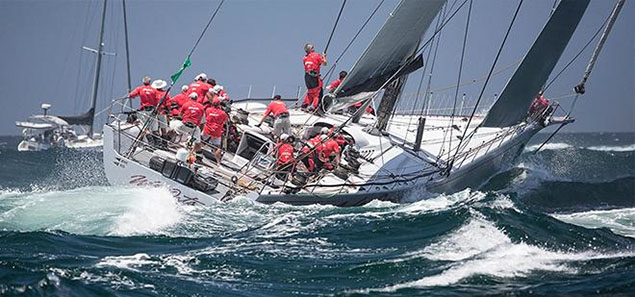 Wild Oats XI has had so much added to her length forward and so much chopped off her stern that she now looks like a one-masted schooner
Wild Oats XI has had so much added to her length forward and so much chopped off her stern that she now looks like a one-masted schooner
Yet at no stage have any of her skillfully-executed hull mods failed. Down in Australia, and in New Zealand too, they’re past masters at doing incredible things with epoxy which, once the job has been finished, look as if they’ve been there from the start. And the fact is that when we look back on the history of sailing development, when timber construction was dominant, the more individualistic shipwrights were game to take on all sorts of challenges for they knew – or at least most of them new – just what could be done with wood while retaining the overall sea-going integrity of the much-changed vessel.
It was only when fibreglass took over as the dominant boat construction material in the 1960s that we went through a period of nervousness of configurational change, when what you got in a plastic boat stayed as what you got in that plastic boat. For a while, people were scared stiff of making any changes to what had emerged from the mould and subsequently from the finishing shop.
But if your boat happened to be of wood, or better still of aluminium or steel, you could emulate the modifiers of old and introduce changes which managed to be locally strong, and also strong within the overall structure of the boat.
Once upon a time, back in 1974, we found ourselves berthed in Crosshaven outside Eric Tabarly’s 64ft ketch Pen Duick VI after an RORC race from Cowes, which he had won both on the water and on IOR. Despite this, the great man was dissatisfied with the location of the sheet leads for the Yankee jib (he had an Illingworth-style cutter rig). So he and his lads got hold of a generator, and there before our very eyes they set up an aluminum welding workshop, cut off the eye, and re-located the sheet leads to the skipper’s satisfaction.
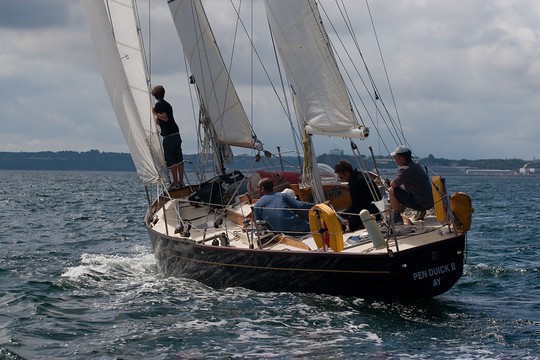 Only the coachroof coaming was timber - Eric Tabarly’s alloy ketch Pen Duick III was easily modified if you’d the aluminium welding kit.
Only the coachroof coaming was timber - Eric Tabarly’s alloy ketch Pen Duick III was easily modified if you’d the aluminium welding kit.
For sure there was singed paint in every direction, but the job was done, and Pen Duick won the next RORC race to somewhere in Brittany even more convincingly, while we sailed home to Howth reflecting that maybe there was more to aluminium than a rather soul-less material best used for building aircraft.
But of course we didn’t need to look very far to see boats that had been modified, sometimes beyond all recognition, in order to maintain appeal to a new generation of sailors. While the Howth 17s of 1898 may have stuck stubbornly to their original design – which they still do – the Dublin Bay 21s of 1902 had since 1963 been changed to Bermudan rig with a new coachroof.
 Dublin Bay 21 in original form – they kept their crews busy, and offered scant comfort or shelter. Photo: Rex Roberts
Dublin Bay 21 in original form – they kept their crews busy, and offered scant comfort or shelter. Photo: Rex Roberts
 The Dublin Bay 21s as they were from 1963 until 1986 - more easily handled, and the luxury of a doghouse,
The Dublin Bay 21s as they were from 1963 until 1986 - more easily handled, and the luxury of a doghouse,
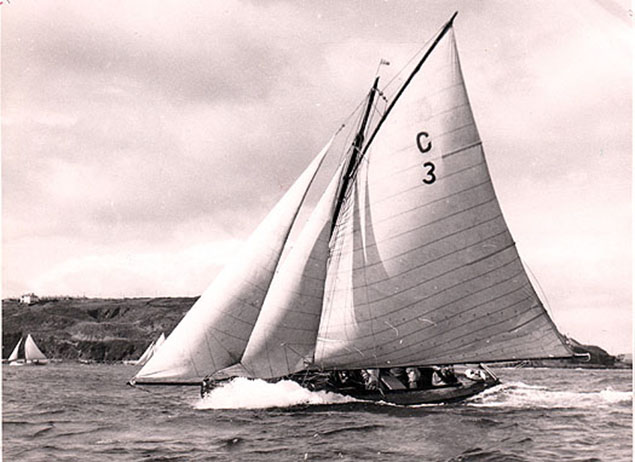 Cork Harbour One Design with classic rig, and open cockpit. Photo: Tom Barker
Cork Harbour One Design with classic rig, and open cockpit. Photo: Tom Barker
 Cork Harbour One Design in bermudan-rigged cruising mode, complete with coachroof and doghouse. Photo: W M Nixon
Cork Harbour One Design in bermudan-rigged cruising mode, complete with coachroof and doghouse. Photo: W M Nixon
And in Cork Harbour, the more senior Cork Harbour One Designs of 1896 vintage had become able little Bermudan-rigged cruisers with an extensive coachroof – complete with doghouse – which allowed them to log some very impressive cruises.
But in both cases, while the boats may have looked completely different above the deck line, their basic hull shape remained the same. Yet if you cared to look in the Coal Harbour in Dun Laoghaire, until the early years of this century a regular resident was the 32ft Bermudan sloop Bonito, which had started life as a plumb-bowed gaff cutter built in Strangford in 1884, yet by the time she reached Dun Laoghaire she was spoon-bowed and sloop rigged under the Bermudan configuration, her owner-skipper being Roy Starkey, whose regular crewmate was Bob Geldof Senr.
In fact, re-configuration seems have been a fact of life for Bonito during much of her existence, as at one stage she was yawl rigged too. But the fascination abut her lay in discerning where the constructional changes had been made to transform her appearance, and it’s a matter of regret that when her life came ignominiously to an end some time after Roy’s death, with the powers-that-be breaking up Bonito and consigning her to a landfill, it was over and done with before anyone was sufficiently aware of what was happening to ensure that her breaking-up a forensic dissection rather than a crude scrapping.
Of particular interest would have been the way in which her straight stem was lengthened into the spoon bow which became fashionable in the 1890s, and has remained fashionable with foredeck crews ever since, as it means you can work at the stemhead without being immersed in every wave, whereas straight stems – or worse still, the reverse stem as seen on CQS in the Hobart race – are a semi-permanent waterfall.
Yacht design undergoes strange mutations which can persist in exaggerated form, and one of the worst was the heavily-canted rudder which began to emerge in the 1840s when the main measurement for handicap and other purposes was along the length of the lower side of keel. The boat builder and designer Thomas Wanhill of Poole in the south of England was soon turning out boats which were significantly larger than their keel length – and hence their rating measurement – suggested, simply by increasing the angle of the rudder.
 John Mulholland’s 1865-built Egeria
John Mulholland’s 1865-built Egeria
So even though the sweetly-steering schooner America with her vertical rudder came across the Atlantic in 1851 and swept all before her, in England the trend towards angled rudders persisted, and in 1865 Wanhill built his most successful schooner, “the wonderful Egeria”, a 99-footer for linen magnate John Mulholland of Belfast, and she performed like a dream despite her markedly angled rudder.
Having the angle enabled the rudder head and the tiller to be well aft to keep the deck amidships clear for crew work, but somehow the idea persisted and indeed became exaggerated until the 1960s, with the Sparkman & Stephens-designed Clarion of Wight, overall winner of the 1963 Fastnet Race, having a rudder which today looks absurd. Admittedly she was a dream to windward, but offwind and particularly with spinnaker set, she was a nightmare on the helm.
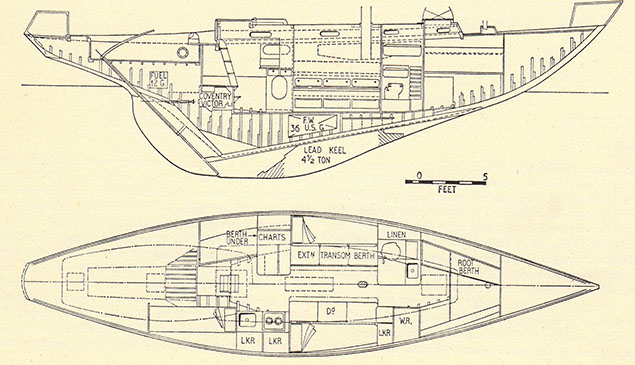 She may have won the 1963 Fastnet Race, but in her original form Clarion of Wight had carried the angled rudder to absurd levels.
She may have won the 1963 Fastnet Race, but in her original form Clarion of Wight had carried the angled rudder to absurd levels.
 Clarion’s successor Firebrand in 1965 showed some modifications to the old rudder shape, but Dick Carter’s new find-and-skeg configured Rabbit won that year’s Fastnet.This particular line of development was knocked in the head when Dick Carter won the Fastnet Race overall in 1965 with his own-designed Rabbit, which was fin-and-skeg with a virtually vertical rudder, and was well-behaved on all angles of sailing. But at the time most sailors persisted in what they thought were improved versions of the old form, and in ’65 Dennis Miller, one of the part-owners of Clarion in ’63, appeared with the new similarly-sized Firebrand with a less steeply-angled rudder which had a pointed tail to give extra power at maximum depth, and that did improve things slightly. But nevertheless Firebrand continued to be the most beautiful-looking boat with the drawback of challenging helming under spinnaker, though as we’ll see, that was to be sorted in due course.
Clarion’s successor Firebrand in 1965 showed some modifications to the old rudder shape, but Dick Carter’s new find-and-skeg configured Rabbit won that year’s Fastnet.This particular line of development was knocked in the head when Dick Carter won the Fastnet Race overall in 1965 with his own-designed Rabbit, which was fin-and-skeg with a virtually vertical rudder, and was well-behaved on all angles of sailing. But at the time most sailors persisted in what they thought were improved versions of the old form, and in ’65 Dennis Miller, one of the part-owners of Clarion in ’63, appeared with the new similarly-sized Firebrand with a less steeply-angled rudder which had a pointed tail to give extra power at maximum depth, and that did improve things slightly. But nevertheless Firebrand continued to be the most beautiful-looking boat with the drawback of challenging helming under spinnaker, though as we’ll see, that was to be sorted in due course.
Meanwhile Clarion of Wight continued to be a handful, so before the 1960s were out, builder Clare Lallow of Cowes was asked to perform the then-major operation of transforming her after-body underwater to give her a fin-and-skeg configuration master-minded by Sparkman & Stephens, who were now advocating this shape with all the zeal of the convert, and in fact had used early versions of it in boats like Deb, later Dai Mouse III, now Sunstone, which had been built in 1965.
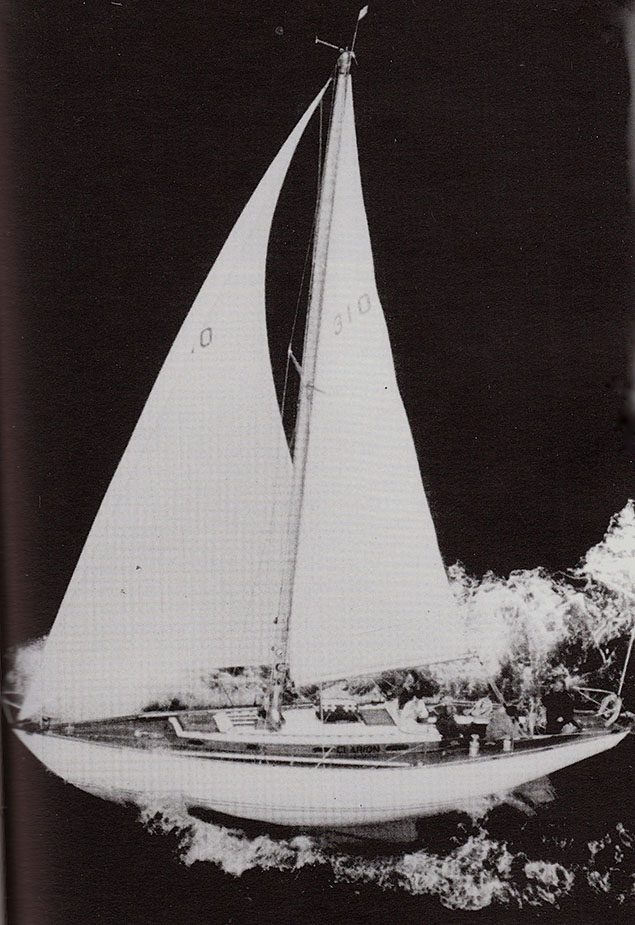 Clarion of Wight in the 1971 Fastnet Race in Rory O’Hanlon’s ownership, when she won the Philip Whitehead Cup. Her new vertical rudder arrangement is discernible.
Clarion of Wight in the 1971 Fastnet Race in Rory O’Hanlon’s ownership, when she won the Philip Whitehead Cup. Her new vertical rudder arrangement is discernible.
Thus to some extent it was the conservatism of owners which persisted in keeping the old style, and of course the vertical separate rudder had long since been advocated by designers like Ricus van de Stadt and Uffa Fox. However, getting the change to into favour with the mainstream in sailing was a different proposition altogether, and you’ll still meet those who prefer keels as long as possible with “gracefully angled” rudders, and good luck to them.
But increasingly the tendency was to the new form, and for those who cannot see any boat without wishing to modify her in some way, it was a magic time, particularly in places like Australia and New Zealand where there seems to be a skilled craftsman round every corner, and regular major boat modifications are almost a way of life.
As for the mainstream, the process was more gentle, but when the most accomplished offshore racers of their generation, the Americans Dick Nye and his son Richard, went to designer Jim McCurdy for a new race boat in 1968, the 47ft alloy-built Carina was given a conservative fin and skeg configuration complete with trim tab on the aft end of the fin keel.
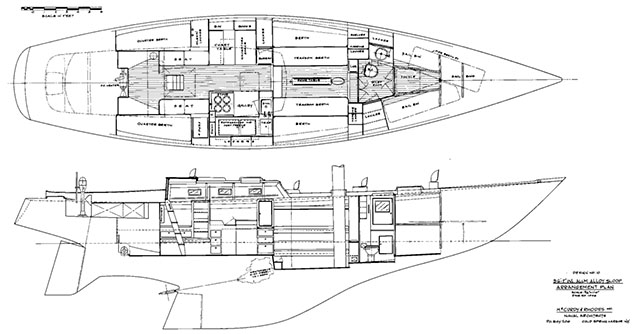 Jim McCurdy’s plans for Carina in 1968 showed a conservative interpretation of the fin-and-skeg form, and relied on a trim tab on the aft end of the fin keel to give added lift to windward.
Jim McCurdy’s plans for Carina in 1968 showed a conservative interpretation of the fin-and-skeg form, and relied on a trim tab on the aft end of the fin keel to give added lift to windward.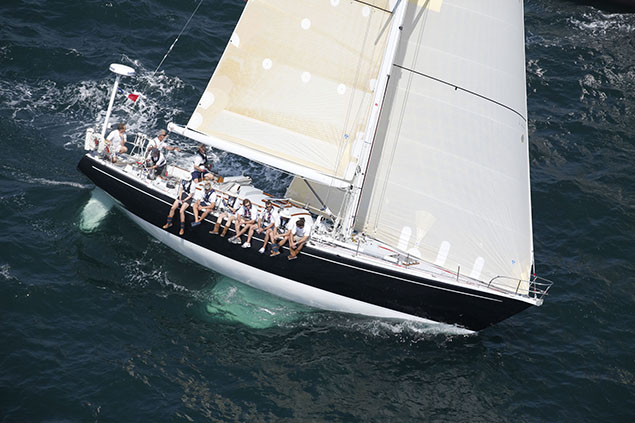 Carina as she is today, and still winning races. She has a spade rudder and Peterson/Holland fin keel arrangement designed by Scott Kaufmann.
Carina as she is today, and still winning races. She has a spade rudder and Peterson/Holland fin keel arrangement designed by Scott Kaufmann.
But that trim tab was punished by changes to the rating rules in the early 1970s. So by 1978 they’d gone to New Zealand-born, New York-based Scott Kaufmann, and he came up with a real dream of a re-configuration with a very positive spade rudder with perfect end-plate effect on the underside of the counter, and a fin keel of the type favoured by Doug Peterson and Ron Holland.
Thanks to Carina’s alloy construction, it was a very manageable job, even if those actually doing it in Bob Derecktor’s famous boatyard found the initial aluminium grinding and cutting to be dusty hard labour. One of that work team was Rives Potts, who has now owned Carina himself for many years, and she continues to win races.
As for her seaworthiness under her new keel and rudder, that was immediately proven beyond all doubt with her successful participation in the 1979 Fastnet. But not all rudder conversions have been so successful. The lovely Firebrand ended up in America, and some owner decided she needed a fin and skeg rudder arrangement. The job was done, but then when she was sold back to Europe, the new skeg broke clean off while sailing Transatlantic. But thankfully it was an add-on rather than an insert into the basic construction, so she got across in one piece.
And then her luck turned. She was spotted by international yacht designer Ed Dubois, who fell in love with her, and decided to make Firebrand his pet boat. Her personally designed a special spade rudder which would retain the classic character of the yacht while improving the steering, and under this arrangement, between intervals of designing superyachts for other people, he had many cherished times sailing and cruising this most beautiful vanished boat before his untimely death at the age of 63 earlier this year.
It’s a great compliment to the beauty of the hull designs of Olin Stephens that a designer of Ed Dubois’s standing should not only choose one of his boats, but at the Dubois home it was a fine photo of Firebrand under sail which had pride of place above the living room fire.
So boats can go through good times as well as bad, and one much worked-on boat which is currently sitting pretty is Anthony Bell’s hundred foot Perpetual LOYAL, line honours winner in the Rolex Sydney-Hobart race, and second overall on corrected time. In that kind of company, it is an achievement comparable with Rambler 88’s performance in the Volvo Round Ireland Race back in June. Yet in all the excitement, how many now remember that back in August 2011, Perpetual LOYAL was Rambler 100, and she was very upside-down with a broken keel out at the Fastnet Rock?
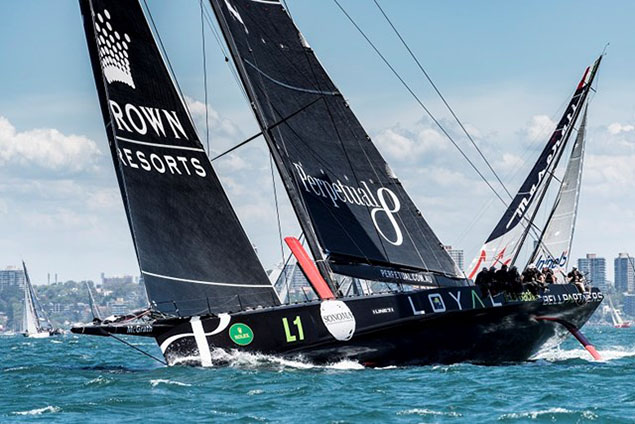 Perpetual LOYAL leads the fleet out of Sydney Harbour five days ago in the Rolex Sydney Hobart Race 2016. Photo Rolex
Perpetual LOYAL leads the fleet out of Sydney Harbour five days ago in the Rolex Sydney Hobart Race 2016. Photo Rolex
 Once upon a time, near the Fastnet Rock..…..Perpetual LOYAL as she was as Rambler 100 in August 2011
Once upon a time, near the Fastnet Rock..…..Perpetual LOYAL as she was as Rambler 100 in August 2011
Phaedo3 Victorious in RORC Transatlantic Race
Lloyd Thornburg's American MOD70 Phaedo3 has taken Multihull Line Honours in the RORC Transatlantic Race for the second year running. The American MOD70 completed the course in 6 days 13 hours 39 minutes and 55 seconds. Although the team was outside their race record set last year (5 days 22 hours 46 minutes 03 seconds), Phadeo3 is well ahead of their 2016 rivals, Giovanni Soldini's Italian MOD70 Maserati, which is expected to finish the race on later night.
Phaedo3 skipper, Brian Thompson, spoke on arrival in Camper & Nicholsons Port Louis Marina.
"Friday evening and we've just arrived into Grenada at the finish of the RORC Transatlantic Race from Lanzarote. We've sprayed ourselves with champagne, given Pablo (Pete Cumming) a birthday cake and now we are going to settle down for some late dinner in St George's. It's great to be here; the tree frogs are singing out, the reggae music is blasting out and we are very happy to be here. We had a great last day in the race with 15-17 knot tradewinds; quite gentle, clear skies and then as we approached Grenada, a beautiful crescent moon and Venus setting in the west in front of us. We arrived three or four hours after sunset and it was a very, very good arrival. There were lots of people to welcome us on the dock.
"Thanks a lot to RORC and to the Calero family in Lanzarote, and to the team at Camper & Nicholsons here in Grenada. We are looking forward to welcoming Maserati in later today, and then we are off up to Antigua. Next stop: the RORC Caribbean 600. It's been a great race."
Team Phaedo for RORC Transatlantic Race:
Brian Thompson
Pete Cumming
Miles Seddon
Kelvin Trautman
Paul Allen
Henry Bomby
Fletcher Kennedy
1987 Fastnet Winner Racing for Ireland Finally Gets Full Recognition
Nearly thirty years ago, the growth of sponsorship in sailing could result in a confusion of results if rules from the era of total Cornithian participation were applied with precise regard for the last letter of the law writes W M Nixon. Thus although there were many sponsored entries racing in national teams in 1987’s highly competitive Admiral’s Cup for which the Fastnet Race was the climax, the peculiar reality was that none of them was eligible – because of being sponsored – to win the Fastnet Challenge Cup for the overall winner.
With a record fleet lining up for the Fastnet Race itself, and with thirteen teams competing with ferocious enthusiasm for the Admiral’s Cup in the best series for several years, it was so hectic in Cowes that the thought of an acute results problem arising in Plymouth after the Fastnet Race had finished was simply not contemplated. Yet this is precisely what happened, and needless to say it was an Irish boat which was right at the eye of the storm.
Stephen Fein’s Dubois 40 Full Pelt was a late addition to the Irish Admiral’s Cup team. Skipper Tom Power of Dun Laoghaire had found that the boat he had originally chartered came with intractable rating problems. But in being forced into relatively last-minute negotiations with Full Pelt, the Irish fell on their feet.
Full Pelt was the result of a dynamic linkup between owner Stephen Fein, his ace boat optimizer and tuner Jo Richards, and designer Ed Dubois. Yet despite being a boat which was clearly showing further potential with every outing, Full Pelt had yet to find a guaranteed team place as the Admirals Cup moved up the agenda.
Negotiations took place with some urgency. With the support of non-sailing Team Captain Sean Flood, sponsorship was secured from the Irish Independent newspaper, and the delicate task of balancing a crew panel between Full Pelt’s core crew and Tom Power’s own talented squad – which included helmsman Tim Goodbody – was set in train. With generous give and take on both sides, a real team spirit emerged, and as the 1987 Admirals Cup got under way, it was clear that Irish Independent was very much a boat to be taken seriously, with Tim Goodbody proving more than a match for international superstars of the calibre of Lawrie Smith.
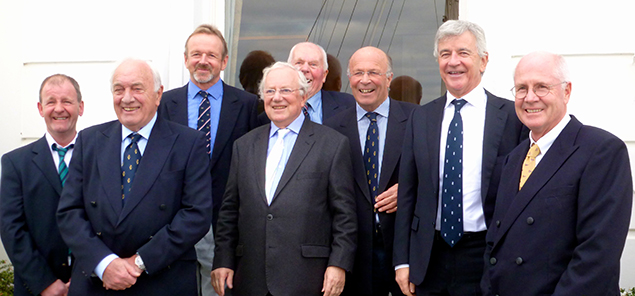
The Fastnet Race itself was a classic. In those days the big race started on the Saturday, and Irish Independent was very much in contention overall as she rounded the rock on the Monday evening. Then with the wind freshening wetly from the west, progress was rapid towards the finish at Plymouth, with the 40-footers finishing in a bunch around 0300 hrs on the Wednesday morning.
This closeness of finish was exactly as Jo Richards had anticipated, and thus he had always been focused on keeping Irish Independent/Full Pelt’s rating a point or two below comparable boats. This meant that while the Richard Burrows-skippered Dubois 40 Jameson Whiskey rated 1.0195, Irish Independent clocked in at 1.0188. As often as not, Irish Independent would be ahead on the water anyway, but there was always this tiny ratings gap to fall back on, something which increased in significance with longer races and particularly with the Fastnet.
So on that wet pre-dawn Wednesday morning, Irish Independent was already well launched on her way to being declared overall winner of the Fastnet Race. But in the euphoria of this achievement, it took a while before it was fully realized that despite the clarity of her victory, there was no way she was going to win the coveted Fastnet Challenge Cup. That would go to the top-placed non-sponsored boat.
In the end, the strongly-bonded band of brothers which had emerged from the melding of two crews aboard Irish Independent/Full Pelt had to be content with receiving a little silver dish – “a leprechaun’s hub-cap” as Tom Power described it – as the only acknowledgement of what they had done.
While everyone knew what the real situation was, the fact that the official records stated otherwise tended to obscure the facts with every passing year, and the untimely death earlier this year of designer Ed Dubois – who had been an active crewmember on the boat during the Fastnet Race – was a reminder that something needed to be done to put things in proper perspective.
Friday December 2nd would normally be a day on which people start seriously anticipating Christmas. But for those for whom Irish Independent/Full Pelt was a very special boat at the centre of an unusual but successful crew-merging project, Friday December 2nd 2016 was the day on which the current Commodore RORC, Michael Boyd, and the 1987 skipper of Irish Independent Tom Power, jointly hosted a lunch in the Royal Irish Yacht Club in Dun Laoghaire to honour the memory of Ed Dubois and to celebrate the sportsmanship and goodwill of Stephen Fein and Jo Richards in throwing themselves so completely into campaigning with a crew of Irish strangers who had become close friends by the time the series was completed.

An official stamp of approval was put on it all by the welcome presence of Janet Grosvenor, Assistant Secretary at the RORC in 1987, and key administrator of the Admirals Cup. And thanks to links with Irish Lights, a new trophy – made from a prism from the light on the Fastnet Rock – was presented to Stephen Fein and Tom Power, complete with the names of the crew.
As for the full supporting cast, it was extraordinary, as it included both the 1987 Team Captain Sean Flood, and the Team Manager Terry Johnson, it also included former RORC Commodore John Bourke who was navigator of Jameson Whiskey back in 1987, and it numbered almost the entire crew panel for Irish Independent/Full Pelt, including those who had sailed some of the races, and those who had stood aside to allow the core squad to race the boat round the Fastnet.
Twenty years were to elapse before another Irish boat was to win the Fastnet Race overall in the form of Ger O’Rourke’s Cookson 50 Chieftain. But now, just in time for the 30th Anniversary of the 1987 Fastnet Race, the record has been put straight as to which boat actually won nearly three decades ago.
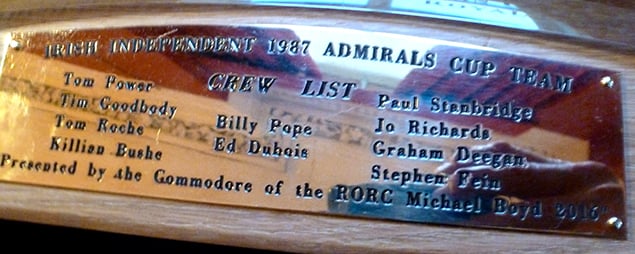 The names of the crew inscribed on the new trophy
The names of the crew inscribed on the new trophy
Phaedo Prepares to Finish RORC Transatlantic Race
Lloyd Thornburg's American MOD70 Phaedo3 is flying towards Grenada's Camper & Nicholsons Port Louis Marina and expected to touch down in about 24 hours. Mike Slade's Maxi 100 Leopard 3 is racing against the clock in an assault on the RORC race record. The IRC Fleet and Class40 Division are getting a savage taste of ocean racing.
MOD70 Phaedo3 is screaming towards the finish line outside Port Louis Marina in Grenada. Skipper Brian Thompson has told the crew to fasten their seatbelts and stow their dinner tables. For nearly a week, the crew have had no more than a few moments sleep in cramped conditions, living off freeze-dried mush and warm desalinated water. A hot shower, a proper bed, delicious food and a cold beer is just a few more hours away! A warm welcome is set for Phaedo's arrival and for Giovanni Soldini's MOD70, Maserati. However the Italian flyer is estimated to be as much as 24 hours behind their rivals.
The crew aboard Mike Slade's British Maxi, Leopard 3 have a huge lead on the water over the IRC fleet, vying to win the IMA Transatlantic Trophy. This morning the powerful Maxi had reduced speed as they passed through a transition zone created by a low pressure system to the north and solid trade winds in the south. The clock is ticking away, as Mike Slade explains via satellite connection:
"What a night! Almost every sail we have took a share of a battering; 80 degree wind shifts and wind speeds ranging from 6 to 40 knots, demanding at least 12 sail changes. Leopard never knew what the fuss was all about! Now into more stable conditions charging along at 16 to 20 knots, still hoping for line honours but the record will be won or lost by a matter of minutes. Once again the drone caused excitement reaching huge heights taking fab photos. We need to finish by 6 December at 1900 GMT, 1500 local time. After last night we all need a rum or two, but will have to wait. 1,500 miles to go."
Leopard's complications have been to the advantage of the variety of yachts that are also racing in the IRC Division. Arco Van Nieuwland & Andries Verde's Dutch Marten 72, Aragon has continued to perform. Approaching the halfway mark, the team are back as race leaders contesting for the RORC Transatlantic Race Trophy, and making a move south to hook into the trade winds. Leopard 3 is estimated to be in second overall, but should increase speed over the next 24 hours which may propel the team back to the top of the leaderboard. Swan 82 Stay Calm is already further south than Aragon and could well make up time on their immediate rival. All of the IRC fleet have now turned south away from the highly unusual westerly winds to the north. However the last 24 hours have been tough going for the Class40 division and smaller yachts in the IRC fleet.
Leader of the Class40s, Halvard Mabire & Miranda Merron's Campagne de France has sent in their latest blog. The team are racing Two Handed:
"Campagne de France, somewhere in the Atlantic on a very dark night. We must have read the wrong brochure. Trade wind route it isn't. Still upwind since the night before last, but on the way to better things, although the wind is refusing to match the forecast at the moment. Upwind = bouncing/ slamming off waves and into troughs. Getting water into the Jetboil and then pouring boiling water into a mug and keeping the contents in it while placing the lid on it are activities best undertaken in foul weather gear and boots, despite the heat. Every four hours we receive a position report (or punishment report depending on performance), where we see how Campagne de France, or more precisely her crew, has fared against the competition. There are still 2,000 miles of race course to go. Many more miles than that to sail as the direct route is closed, at least if we want to get to the finish this year, and a lot can happen in that time," writes Miranda Merron.
James Heald sent an SMS via satellite from on board his IRC Two Handed entry, Swan 45 Nemesis. James and his crew Ben Harris have 2,000 miles to race to complete an epic challenge.
"Man thinks he's king of the world. Yet Mother Nature rules out here as we beat into 20 knots, of that there is no doubt. Course is sort of towards Grenada; it's going to be a long one. Boat and us getting a beating today and looks set to continue before we hit forecast light winds again. Perhaps the southerly route via the Cape Verdes would have been more favourable, though I still believe in the Rhumb, or is it Rum! Routine and camaraderie are our friend, from our daily Iridium forecast we continue to execute our best attempt at using these contrary conditions to our goal. Ben broke a finger nail today. Me, I am just racing my yacht in an iconic race on my own terms and at times wonder WTF I am doing. One things for sure, it's a true adventure and that's what we were put on this planet to do: explore, sail, live. Checking off watch," Capt James Nemesis.
Record–Breaking Rambler 88 Does it Again
George David's super-maxi Rambler 88, overall winner and record breaker in the Volvo Round Ireland race 2016 back in June, has added a new accolade to her already enviable sailing reputation as she crossed ARC Finish Line in Rodney Bay, Saint Lucia 15:14:15 local time (19:14:15 UTC) on Monday 28 November to break the ARC Course Record. Departing Las Palmas de Gran Canaria at 12:45 on 20 November alongside over 200 boats in this year's Atlantic Rally for Cruisers (ARC), the Juan K. designed cutting edge racer has been pushed to her limit by an impressive professional crew of sailing legends. Fellow boats in the ARC Racing Division, including many of the previous record holders sailing on board VO70 Trifork, were left in their wake; even light winds were not going to stop Rambler's mission to claim the record.
The new course record now stands at 8d 6h 29m 15s beating the previous time by 1h 10 minutes and 15 seconds. In 2015, Team Brunel sailed 3343.3nm based on the YB track at an average speed of 16.8 knots. Winds have been lighter than last year, however Rambler 88 took advantage of a small depression which formed mid-Atlantic soon after the start, enabling the boat to sail a very northerly route and then have a fast reach down to Saint Lucia. Overall, they have sailed approximately 270nm less than Team Brunel, which has been a crucial factor for this year's lighter wind crossing.
This is the fourth consecutive year that the Course Record has been beaten; a year ago VO65 Team Brunel claimed the title from Farr 100 Leopard by Finland. Mike Slade's super-maxi had taken over two days off the previous record set by Caro, a Knierim 65 in 2013. A growing tradition of sleek, high-tech racing yachts joining the ARC seems to have developed, with the rally offering a different environment to sail these impressive machines from the pro-racing circuits. This was the first time sailing in the ARC for Rambler 88, and before setting off from Las Palmas de Gran Canaria Project Manager Mick Harvey commented, "It's been a really good experience dealing with the organisers of the ARC. Everyone is very helpful and it's quite an eye-opener for someone coming from the racing side, which can be quite combative. George David, Rambler 88's owner, really wanted to join in with the ARC because he enjoys transatlantic crossings and scheduling-wise, this worked well."
Harvey played down the expectation that breaking the record was a foregone conclusion when Rambler 88 set off from Gran Canaria, "I think every time we go out there with this boat there's an opportunity to break the record, but the conditions at the start of this race didn't look like they were going to be indicative of breaking the record at all. In Las Palmas, the fastest it looked was maybe 8 days, maybe, and it could easily have been as long as 9 or 10 days. Luckily they managed to hook into a couple of good systems initially and then they were off and running."
Reaching the dock, Rambler's owner George David echoed that the main challenge this year was the weather and the lack of wind has kept the crew guessing to the final hours, "Once we set off, we were confident we could make the crossing in 8 days, but the record was less certain, right up until we crossed the finish line really. Two squalls came across us in the morning bringing torrential downpours but no wind so that slowed us down even more. Given the challenges this year, we are thrilled to have broken the record!"
Arriving in Saint Lucia, Rambler 88 received a fitting welcome. Not only did they break the course record, but they are also the first yacht sailing under the ARC banner to reach Rodney Bay in 2016. Usually, boats from the ARC+ Cape Verde fleet have begun to make landfall, but the low pressure system haunting the rhumb line this year has slowed their progress. Sailing from Mindelo in the Cape Verde, they have a shorter distance of 2090nm for the second leg of their Atlantic crossing, and departed on Wednesday 16 November, four days ahead of the ARC boats sailing 2,7000nm directly from Gran Canaria. It's a testament to Rambler's navigation and tactics that they have lead the advent of ARC yachts into Saint Lucia and the Rally Control team together with Saint Lucia Tourist Board and staff of Rodney Bay Marina are looking forward to welcoming the rest bumper fleet in the coming days and weeks
Director of RORC Rating Office
An exciting opportunity has arisen for a highly motivated and enthusiastic sailor with a technical background to take over the day to day management of the RORC Rating Office based in Lymington, Hampshire, UK.
Reporting to the Chief Executive the applicant will be one of the senior executives in the RORC organisation managing and motivating a small but highly experienced professional team at the Lymington office. This high profile and multi-faceted role has influence on the sport shaping both the competitive enjoyment of sailors worldwide through the IRC rating system as well as the management of yacht measurement, the safety aspects of the sport and the creation and maintenance of class rules for a variety of offshore one designs.
The successful candidate must have a high level of understanding of the technical elements of yacht performance, a good knowledge of yacht racing, and be computer literate, capable of learning the processes of our bespoke development software. They will be expected to develop longer term strategies for the IRC rating system and ways to develop the sport of sailing, encouraging more sailors to compete at all levels. The role involves travel between the various RORC offices and to venues in the UK and overseas to discuss and develop RORC's relationships with other organisations and stakeholders such as UNCL our partner in IRC and the ability to speak with authority and knowledge about the technical and safety aspects of the sport.
Other responsibilities include budget creation and management, developing measurement techniques and managing the team of RORC/IRC measurers around the UK as well as being available to assist with any yacht measurement matters. A sound knowledge of WS RRS & ERS, related ISO standards and STIX as well as the history of rating systems would be advantageous.
An attractive salary and benefits package includes a pension scheme, life insurance, 25 days annual leave plus public holidays.
Please send a CV and covering letter to: [email protected] or post for the attention of:
Eddie Warden Owen
20 St James' Place
London SW1A 1NN
Closing date for applications is 23rd December 2016.
Interviews will be held in London the week commencing 9th January 2017.


